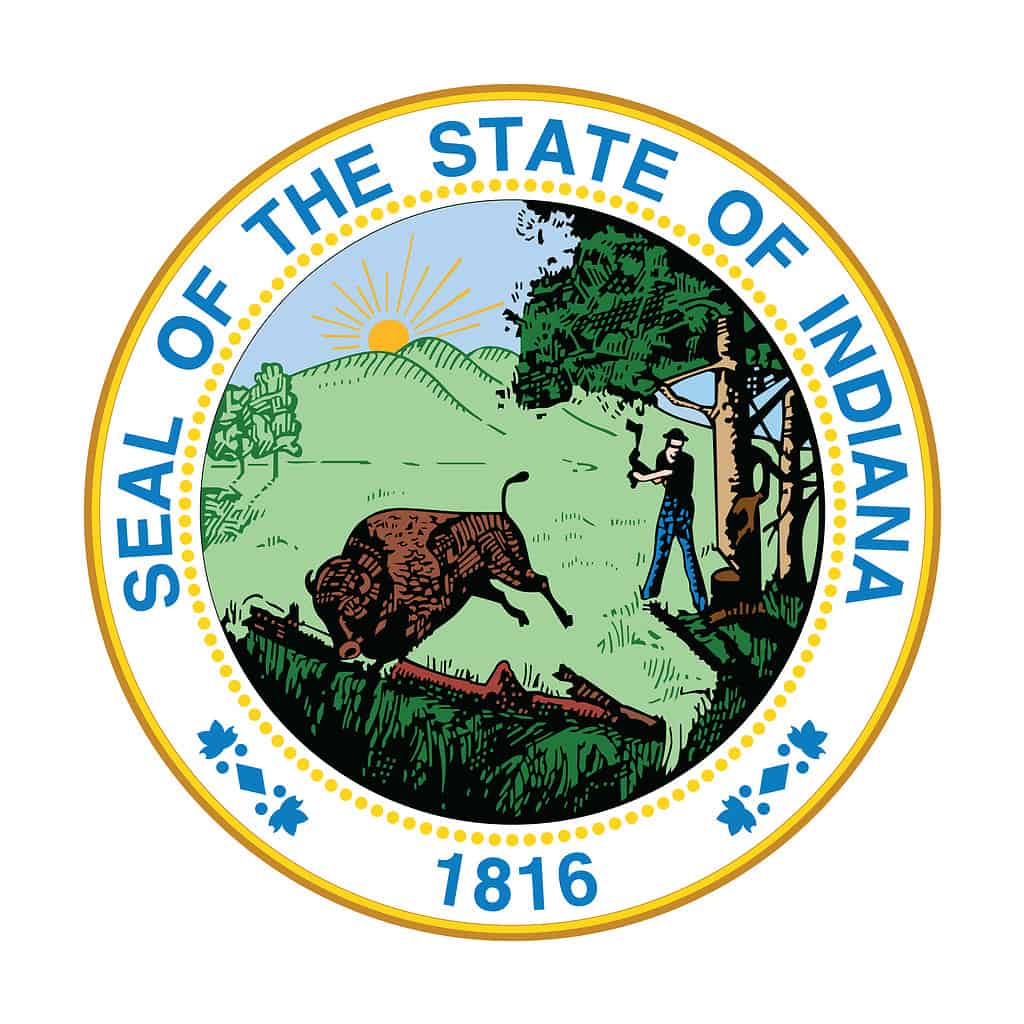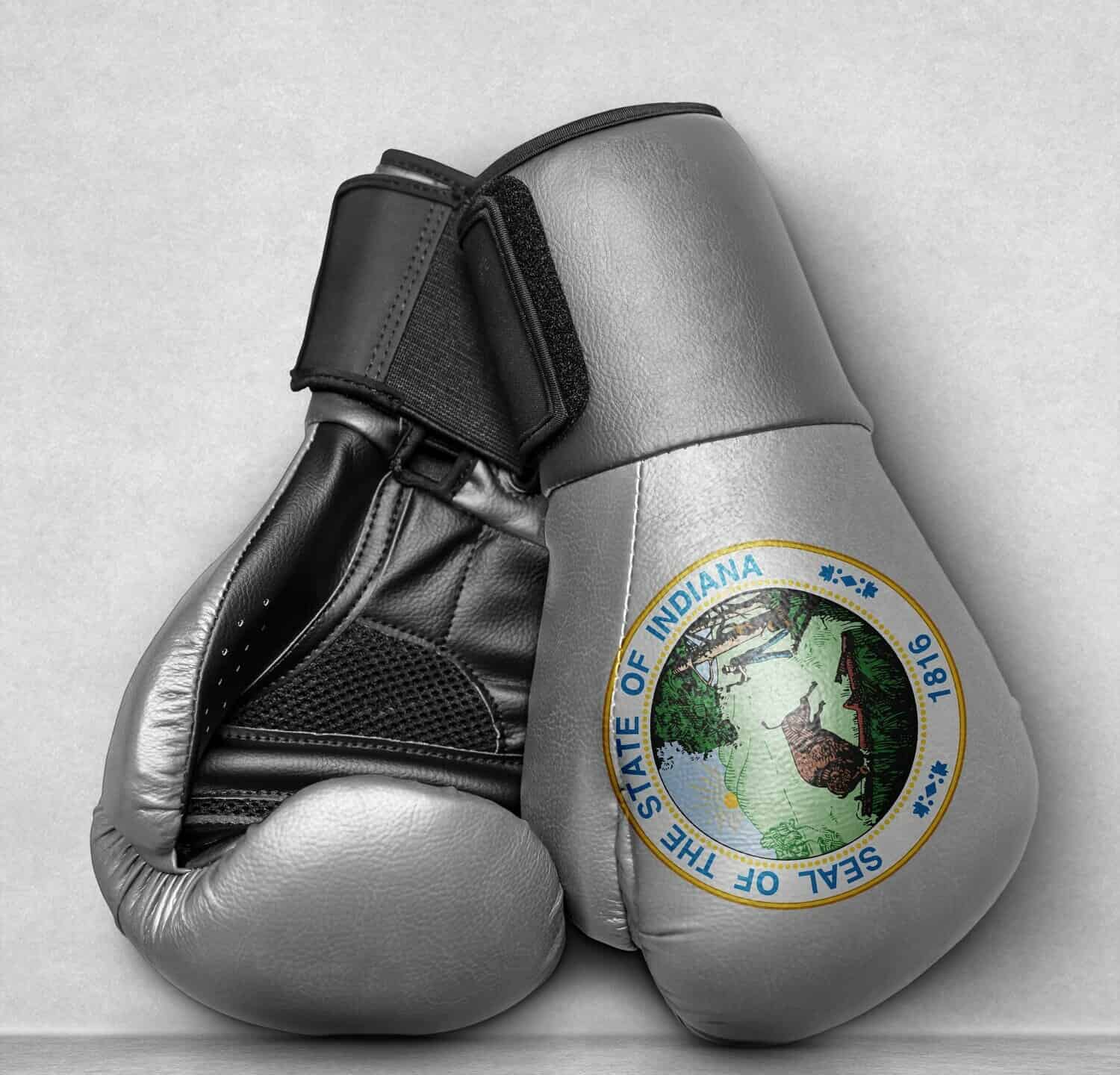The state of Indiana is a great and beautiful place to live and visit. Known for farmland, steel mills, the University of Notre Dame, and the Indy 500, it’s a culturally relevant place founded way back on December 11, 1816, as the 19th state in America. Today, we will talk about the Indiana state seal, including its description, history, symbolism, and more. Without further ado, let’s jump into this important history lesson.
What is the Indiana State Seal?

There’s a lot going on in the Indiana state seal but its an incredibly influential seal.
©iStock.com/bodrumsurf
Found on official Indiana papers as early as 1801, the Indiana state seal is round. It has the year 1816 printed on it, which is when the state officially joined the country. While it was provided for the 1816 and 1851 Indiana constitutions, it wasn’t officially described by the Indiana General Assembly until 1963.
A perfect circle at two and five-eighths (2 5/8) inches in diameter, the seal includes a woodsman that is chopping down a tree with an ax. Nearby, there’s a buffalo jumping over a log. There’s also hills in the background as the sun sets with fourteen rays. The buffalo is facing to the left, back feet in the air, as it jumps over the log.
The tree on the seal is a tulip poplar (Indiana’s state tree), and the diamond shapes around the outside of the seal are meant to look like the leaves of that tree. The seal also features two sycamore trees on the right. The larger one is nearer to the center, and it has a notch cut out of it about midway through.
Story of the Indiana State Seal
Make no mistake. This is not a seal that they came up with overnight. Instead, it comes with years of history that goes back to 1787.
The Story Starts in 1787
In a book by William Hayden English, called Conquest of the Country Northwest of the River Ohio, the author describes the origins and description of a potential seal of the Northwest Territory while working with the United States Department of State. In the book, there are copies of letters he received as he was working to construct the complete seal image.
Some say that the first official mention of a seal was by then Governor Arthur St. Clair’s proclamation that he wrote in 1788.
The seal back then was described a bit differently. According to English, the seal could feature a coiled snake in the foreground. There were boats in the middle distance, a rising sun, and a fallen tree that has been chopped into logs.
Moving Onto 1800
After 1800, there were a couple of mentions of an Indiana state seal. In January 1801, a seal was then included on court documents that were signed by Governor William Henry Harrison.
Then, on papers signed in 1802, the seal appeared again. The papers in question were Slavery Petitions and Papers created by Jacob Piatt Dunn. With them, he added a note about a seal that was used in a document. His note said that this was the seal of Indiana: It features a setting sun, buffalo, and man cutting trees, but not the same as now. The buffalo’s tail is down-the opposite the sun. And that the word Indiana is on a scroll in the branches of the tree.
A Bill was Introduced in 1816
According to the 1816 Indiana State Constitution, Article IV, section 26, it was decided that there shall be an official state seal.
This prompted a bill created by the Indiana House of Representative. It asked for an official seal and press to be created. The bill passed the house and it was amended by the Senate, Then those amendments returned to the House on November 22, 1816. While there, Representative David Floyd added that there would be a forest and a woodman felling a tree. That there’d also be a Buffaloe leaving the forest and fleeing through a plain and going to a distant forest. Finally, the sun would sit in the west with the word Indiana.”
The amendments and changes went to a conference committee, and both houses agreed on the changes. Surprisingly, no official record survived. So, the seal was still not official.
Other Parties Get Involved in 1895
In 1895, Robert S. Hatcher, reading clerk of the Senate, was appointed to officially investigate the status of the Indiana state seal. In a report he submitted on March 8, 1895, he confirmed that no official state seal had been created.
He noted “The general design of the device now used as the seal of Indiana is a legacy from territorial days. That it has been in use for nearly a century. He continued that it seems to be the consensus of opinion that the general characteristics of the original seal have, for nearly a century, represented the dignity and authority of Indiana. He said that the essential features of the old design should be preserved.”
In response to this, Senator McCord introduced a new Senate Bill 486 in March 1895 to provide the use of “public seals and for the purchase of a seal of the state,” but no further action was taken. However, it’s worth noting that the state seal he described in that bill was a circle that included a woodman felling a tree to the right in perspective. Also, the setting sun; a buffalo fleeing through a plain to the left. And at the top of the device, the motto, ‘Loyalty.’
1905 Seal Discussions
In an edition of the Indianapolis News on January 28, 1905, the proposed state seal was brought to the attention of the people.
Some critics had issues with the fact that the seal featured the sun setting behind the mountains in the background. The problem they had was that the sun was setting in the west and that the mountains were an incorrect aspect of Indiana’s scenery. They said that the western horizon of Indiana was flat and that there were no mountain ranges this side of the Rockies. They believed that the seal was made by someone who lived elsewhere and didn’t understand the topography of the west.
In the article from the Indianapolis News, it was stated that “Perhaps the stationary sun about to set behind a range of mountains. They thought it could maybe change so that the sun wasn’t setting but instead rising in the east.
Early Description of the Seal and Iconography
In the book called Indiana and Indianans, author Jacob P. Dunn, acknowledged that the initial look of the seal has been a bit of a joke to some. He said that perhaps it’s not a setting sun, but instead a sun rising on a new commonwealth west of the mountains, or the Allegheny Mountains. That the woodman represented civilization subduing the wilderness and that the buffalo going west was meant to signify a “primitive life retiring in that direction before the advance of civilization.” The seal he described was printed in his book.
The Seal Becomes a Reality in 1963
In 1963, Indiana representatives officially described and adopted the state seal that we see today. They wanted to make sure that the perimeter of the seal was encircled with the wording, “Seal of the State of Indiana.”
On March 11, 1963, act number 1348 was sent from the House of Representatives to Governor Matthew E. Welsh and he approved it. The seal was official.
Very little action was taken after that point. In 2004, Representative Luke Messer put forth a bill that would change the setting sun to a rising sun. In 2005, a follow-up bill made this change in the official description of the seal.
Usage

The Indiana state seal is found on official documents and many other items around the state.
©Bennian/Shutterstock.com
Until this day, the Indiana state seal is used by the government for official paperwork. It’s used to certify the authenticity of official state documents. It’s placed on departmental reports, bills to the Governor, and official communications from the Governor to other high-ranking officials.
Conclusion
This concludes the epic history of the Indiana state seal and everything it means to the people of this wonderful state. Like every state, this seal was not created overnight, but now that it’s official, it’s a great piece of art that means a great deal to the people of Indiana.
Thank you for reading! Have some feedback for us? Contact the AZ Animals editorial team.








